Extreme Risk is another example of Star Trek: Voyager squandering an intriguing premise.
Hunters introduced a number of new and intriguing ideas to Voyager. Suddenly, Janeway was no longer in a long-term relationship with Mark, which made it possible for her to consider romantic entanglements in the Delta Quadrant. Suddenly Starfleet was aware that Voyager was still in one piece, rather than missing in action. These creative choices opened up new storytelling possibilities, paving the way for episodes like Counterpoint or Pathfinder.

Diving right in.
However, the most interesting revelation in Hunters was that the Maquis had been destroyed while Voyager was lost in the Delta Quadrant. This was not a surprise to Star Trek fans who had been watching Star Trek: Deep Space Nine, given that this development had been covered in Blaze of Glory. However, it should have been a big deal to the characters on Voyager. Chakotay and Torres were members of the Maquis. Tuvok had been a spy working for Starfleet in the Maquis. Even Paris had spent some time in the organisation. This news should have been a big deal.
Extreme Risk feels like an interesting development of this idea, albeit one that has been greatly delayed. How would the Maquis crew members react to the news that most of their friends were dead and that the rest were in Federation custody? Voyager has never been a show particularly engaged with long-term consequences, but there is an interesting story to be told there. Extreme Risk tells one such story, suggesting that the new plunged Torres into a depression that led her to self-harm. It is certainly an intriguing and compelling story hook.

Building a better future.
However, Extreme Risk fumbles the delivery in a number of ways. It makes the standard Voyager mistake of assuming that character-driven plots still have to have a compelling action-adventure element to them, and so provides a very generic subplot about a probe that has been lost in the atmosphere of a gas giant and the resulting “old-fashioned space race” that results, including the construction of a new ship. As a result, the plotting of the episode feels very trite, offering Torres a very convenient clear-cut redemption arc at the climax.
That said, the biggest problem with Extreme Risk is much more basic than the awkward juggling of primary and secondary plots. As with Night before it, Extreme Risk demonstrates that the rigidly episodic structure of Voyager is woefully ill-equipped to tell a profound (and sincere) story about the struggles of living with clinical depression.

She knows kung fu.
Extreme Risk began as a story idea with Roxann Dawson. The actor had been fascinated with the notion of clinic depression as a psychological illness. As she explained to Cinefantastique, she was thrilled that the writers decided to do something with it:
Explained Dawson, “We were talking about the nature of depression. I had some ideas for B’Elanna about exploring that side of her. I started to elaborate on some of my ideas, and they were really interested. They said, ‘We’ll do something with that,’ but I didn’t expect to hear anything. Then all of a sudden this episode was handed to me. It was really great to see some of my ideas about B’Elanna’s darker side explored by these writers.”
Dawson continued, “I was pleased with the writing. It’s always hard to explore a subject like that. I am never satisfied with my work, so I’ll always find problems. I think for the most part it really did accurately explore a very difficult quality to put on film, without being trite and without being predictable. I think that they explored this self-destructive nature of hers in a really original way, and I appreciated that. It’s also an area that Star Trek doesn’t deal with very much. I appreciated their risk, to quote the title, of going there, spending time in a show exploring just one aspect of an emotional nature that had nothing to do with science fiction.”
Many Star Trek stories are heavily influenced by the actors involved. Leonard Nimoy would send extended memos on scripts to the production team on the original Star Trek, offering insight and analysis. He would earn story credits on Star Trek IV: The Voyage Home and Star Trek VI: The Undiscovered Country.

Reflections.
Dawson’s idea was very clever, at least in theory. One of the big problems with Voyager is that the series has a tangible reluctance to tell bona fides character-driven narratives. Voyager could never produce an episode as effective as the more character-centric stories on Deep Space Nine, whether powerhouse dramas like Duet or Waltz or even more modest successes like The Sound of Her Voice or Chrysalis. The writers on Voyager are fixated on the idea that plot drives these episodes, and that the characters are ultimately passengers.
There is a great story to be told about Torres’ depression in Extreme Risk, just as there was a great story to be told about Janeway’s depression in Night. However, the big problem with both Night and Extreme Risk is the need to feel like conventional episodic adventures with dramatic final-act action scenes. Voyager is a show that loves its science-fiction high concepts, and is never willing to let its attention drift away from those big story ideas long enough to develop its characters or allow them room to breathe.
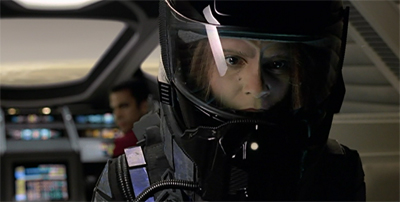
Torres does not have the best add visors.
To be clear, there is a lot to love about Extreme Risk. Roxann Dawson does great work with the material, and this character development seems organic for Torres. Torres has always struggled with her emotions, and it seems logical that this anger and this guilt would eventually “overload”, whether rendering her emotional numb or simply channeling that anger back towards herself. Torres has always been the character on Voyager with the roughest edges, and the story seems particularly suited to this narrative.
However, there is more to it than that. There are beats in Extreme Risk that ring very true, and are all the more effective for that emotional truth in the context of the science-fiction setting. Most of the dialogue in the episode is pretty corny, but a lot of the small behaviours feel like a natural fit for the story being told: Torres trying her best to disguise her injuries from her friends and relatives, understanding that they would only try to stop her if they knew; Torres seeming indifferent to those around her; Torres seeming any excuse to throw herself back into the holodeck.
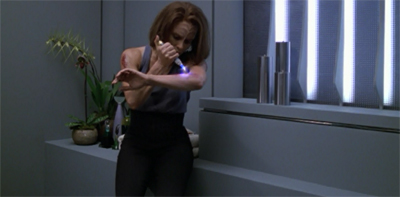
I hurt myself today.
That said, there are some problems. Discussing the episode with Cinefantastique, writer Kenneth Biller explained that the use of the holodeck in the episode resulted from the need for a science-fiction story element:
The idea for Extreme Risk came from Roxann Dawson. She was interested in this notion of self-harm, the phenomenon that exists, if you look at the psychiatric journals, mostly among women. Because of depression or some mental disorder, people will hurt themselves. It’s theorized that people do that because they are trying to provoke some kind of emotional response, it’s a very simplistic way of putting it, but to let themselves know that they are still alive. B’Elanna is beginning to experience this phenomenon of feeling numb. We have to put this in science-fiction terms, so she was going on the holodeck to try and get herself hurt to prove to herself that she was still alive.
There is nothing wrong with the use of the holodeck in Extreme Risk. If anything, the use of the device is quite clever. “Self-harm by holodeck” is a very logical abstraction for the futuristic technology.
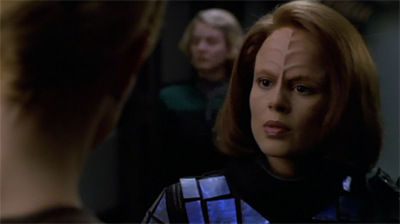
Voyager is not suited to this storytelling.
More importantly, the use of the holodeck in Extreme Risk enhances rather than diminishes the core themes. Like the use of advanced cosmetic surgery in Duet or the contrivance of the distress beacon in Waltz, it is a science-fiction element that serves to make the narrative more efficient to allow more room for psychological inquiry. Extreme Risk is not an episode about the holodeck in the same way that Alter Ego or Worst Case Scenario might be. It is just a story that uses the holodeck to illuminate its themes and preoccupations.
However, Biller’s fixation on the necessity for a science-fiction plot element does underscore a very real issue with Extreme Risk. The subplot involving the probe and the Delta Flyer feel completely superfluous and unnecessary. These additions to the script are designed to ensure that the story remains an action-adventure science-fiction narrative. Extreme Risk can build its primary plot around Torres’ clinical depression, but there are still necessary plot beats that have to be hit and exposition that needs to be delivered. This is a recurring problem with Voyager.
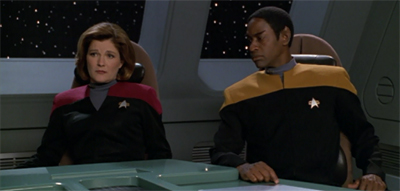
“Sorry, we’d deal with B’Elanna’s depression, but the Malon are back.”
The writers are reluctant to let interesting and atypical narratives play out without falling back on more conventional elements. The Swarm explores what it would be like for the EMH to develop Alzheimers, but the ship still has to face a deadly enemy threat. Macrocosm was intended as a mostly-silent episode, but that was quickly nixed. Real Life focuses on the EMH’s new holographic family, but it still needs a subplot about Paris being lost in subspace. Day of Honour develops the relationship between Torres and Paris, but still needs a confrontation with aliens.
So, much like Night did, Extreme Risk throws Voyager into conflict with the Malon again. It plays out through a subplot in which Voyager competes against the Malon to recover a lost probe from the atmosphere of a gas giant. This subplot feels like a very awkward fit for an episode like Extreme Risk, because it creates a jarring tonal dissonance. Torres is dealing with her depression and a desire to self-harm, while her boyfriend is giddily building a new shuttle craft as part of an “old-fashioned space race.” It is disconcerting.
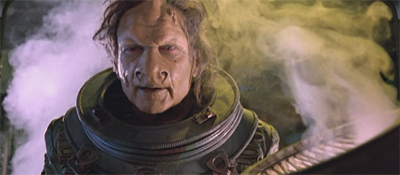
The Malon: Star Trek‘s answer to The Babadook.
More than that, the subplot focusing on the Delta Flyer showcases a recurring weakness of Voyager as a television series. Paris has an entire briefing set up to outline his plan for the ship. “Behold the Delta Flyer,” he boasts. “Ultra-aerodynamic contours, retractable nacelles, parametallic hull plating, unimatrix shielding based on Tuvok’s brilliant design for the multispatial probe, and a Borg-inspired weapons system.” These words are complete nonsense, but Extreme Risk strings them together as if they actually mean something.
However, that is not enough of itself. The other characters then begin contributing technobabble. “Basic design elements are adequate,” Seven observes. Kim give it a little more thought. “If we used isomagnetic EPS conduits in the plasma manifold, we could maximise the power distribution,” he reflects. Even Tuvok gets in on the fun. “My shield designs could be successfully applied to a vessel of this size.” The scene is really disconcerting, as if the production team are uncontrollably excited about a this new (fictional) shuttle.
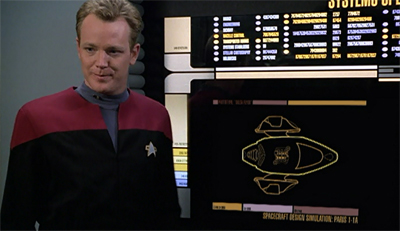
According to plan.
Voyager tends to fetishise technology, luxuriating in empty exposition and meaningless technobabble for its own sake. It would be enough to have Paris pitch the Delta Flyer and periodically check in on construction. Instead, Extreme Risk keeps cutting back to meaningless debates about hypothetical futuristic technology like some weird twenty-fourth century version of Top Gear. None of this is important, and none of this is as important as Torres’ psychological welfare.
At one point, Tuvok and Paris get into a very heated argument about the texture of the controls on the ship. “I suppose these useless design elements from your Captain Proton scenario will compensate for the problem,” Tuvok passive-aggressively snipes. Paris protests, “Hey, every one of these knobs and levers is fully functional.” Tuvok responds, “And completely superfluous.” Paris elaborates, “Maybe to you. I am tired of tapping panels. For once, I want controls that let me actually feel the ship I’m piloting.”

Leverage.
It is a very weird sentiment, because it presupposes that knobs and levers are a more convincing way to fly a twenty-fourth century starship than a touch-screen interface. It is a surreal debate about authenticity, given that the audience will never get to experience either sensation first-hand. It seems strange that Voyager should be so preoccupied with such a trivial gauge of authenticity. It seems like a strange argument to have between two characters dressed in pyjamas, when one of them is also wearing a false set of ears.
It is the kind of logic that leads to goofy action beats like Riker flying the Enterprise with a joystick in Star Trek: Insurrection. It also plays into the assumption that Star Trek: Enterprise is somehow more relatable to audiences because they call their magical device a “protein synthesiser” rather than a “replicator”, or because the ship can only travel at eighty-three times the speed of light rather than eight hundred at thirty times the speed of light. It is a strange debate to merit such time or attention.
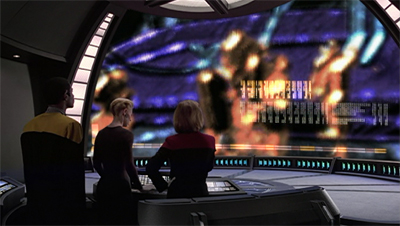
Designing new shuttle craft is so hot right now.
However, this fixation on technology is reflected even beyond the Delta Flyer itself. The entire plot is spurred to action by a mission to recover a lost probe. However, as Chakotay actually states in one of the episode’s more awkward pieces of technobabble, “It’s not just any probe. It’s multispatial technology.” That sounds like something from a twenty-fourth century advertisement. In the world of Voyager, it frequently seems like technology is far more important than the characters who operate it.
Indeed, Extreme Risk even teases the idea that the Delta Flyer should represent the next step in the development of the relationship between Paris and Torres. “How many times have we talked about how great it would be to do what we’re doing now?” Paris asks Torres, which seems like a bit of a cheat since this is the first time that the pair have discussed it on-camera. “To really collaborate my piloting skills and your engineering expertise. We finally get the chance to create something together from the ground up and you’re not the slightest bit enthusiastic?”

Paris’ baby.
Paris makes it sound like an act of reproduction, as if the pair are having a child together. The Delta Flyer remains a source of anxiety for Paris and Torres in episodes like Drive or Alice, taking on a highly symbolic value in their relationship. This is very much in keeping in how Voyager tends to approach technology, suggesting that building a shuttle craft might be equivalent to creating a new life form. It is no surprise that Voyager should engage so readily with the Borg. Voyager seems as engaged with its technology as with its flesh-and-blood characters.
To be fair, the subplot is distracting and frustrating, but it is not the most serious problem with Extreme Risk. The biggest issue with how Extreme Risk approaches Torres’ depression is the same issue with how Night approaches Janeway’s depression. Quite simply, depression is rarely something that just appears and disappears. It is not an illness with a simple cure. It is a condition with which many people must learn to live. It can be treated, and those suffering from it can live productive lives, but it very rarely just goes away.
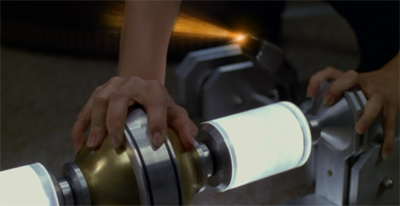
“Technobabble to the rescue!”
As Jonathan Rottenberg explains, living with depression is like living with chronic pain:
Some 38 million American adults struggle with depression. The World Health Organization projects that by 2030, the amount of disability and life lost due to depression will be greater than that from war, accidents, cancer, stroke, or any other health condition besides heart disease. Richard A. Friedman recently wrote, “Of all the major illnesses, mental or physical, depression has been one of the toughest to subdue.” Despite 26 different antidepressants to choose from, only a third of patients with major depression will experience a full remission after a round of treatment. Newer antidepressants are no more effective than those developed nearly 60 years ago.
Our main approach to depression is biomedical and assumes that depression is an illness. Yet the search to discover a fundamental defect in the brain that causes depression has foundered. There remains no biological test to diagnose depression, despite hundreds of physical assays, nor are there any genes that strongly predict it. Brilliant scientists cannot find the defect — even if they look with different or more expensive toys — because their search is animated by the wrong question: Where is the disease?
It is a harrowing mental illness, one that is not treatable through blowing up wormholes or eating banana pancakes.

But, on the other hand, they are very good pancakes.
To be fair, this is less of a problem with Night and Extreme Risk and more of a problem with Voyager itself. By this point in the run, Voyager has largely abandoned any hope of telling long-form stories or plotting long-term character arcs. Voyager is not a show that will set a clear direction for a character (or a pair of characters) at the start of the season and remain true to that vision from one end of the season to the next. Even if there are recurring themes that play out across a given season, Voyager still plots from episode to episode.
As such, the depression plot lines in Night and Extreme Risk need to be self-contained. They need to wrap up neatly in forty-five minutes. They need to be cleared away at the end of the hour, so that the writer working on Juggernaut doesn’t have to worry about acknowledging a character point from early in the season. Voyager packages its episodes into neat forty-five minute stories, tidy narratives that can be packaged and sold into syndication, broadcast in any order without confusing or challenging the audience. This is a shame.
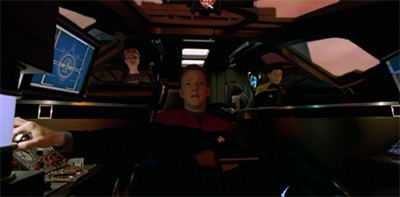
“But don’t worry, viewers totally won’t be confused by my badass new shuttle craft.”
It is possible to construct a compelling an engaging narrative of depression on television. As Stephen Kelly notes, one of the most compelling televisual studies of depression would be arriving less than a year after Extreme Risk:
TV is typically better at dealing with depression, for the simple reason that portraying a long, dense illness is easier in a long-form medium. Take The Sopranos, which was able to unpack the depression and panic attacks of its macho mob boss Tony Soprano across 65 hours of television, building a psychological profile of considerable depth. Yet Tony’s bed-bound bouts were offset by the exciting mechanics of the mafia. And even for soaps such as EastEnders and Corrie, which never end, there’s only so long that a plot-line can be sustained.
If long-form narratives like The Sopranos struggled to do justice to stories about depression, what chance did a single episode of Voyager have, particularly if the narrative was forced to share space with a more conventional plot?
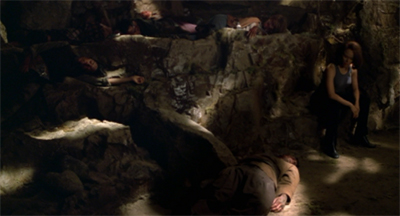
Dead ends.
To be fair, Extreme Risk does have some advantages here. The plot is clearly building off the revelations in Hunters, when Chakotay told Torres that the Cardassians and the Jem’Hadar had all but extinguished the Maquis. This makes sense as an inciting incident, as an event that would plunge Torres into depression. It is a very clever piece of storytelling, one that builds upon a plot point from an earlier episode in a very organic way. It is the kind of continuity that Voyager largely avoids, and so it is exciting to see it incorporated into Extreme Risk.
Of course, there are any number of logical issues her. Chakotay suggests that Torres has been running these dangerous holodeck programmes since “the day after [he] gave [her] the news about the massacre.” That would imply that Torres has been self-harming for more than half a season at this point. This is obviously an example of retroactive continuity, it is hard to reconcile with her late fourth season characterisation because the writers did not have it in mind when they wrote those episodes.
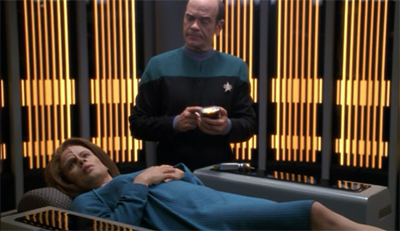
“You know, I probably should be a larger part of this episode, but my actual knowledge of how depression works would just get in the way.”
After all, Torres’ depression and self-harm does not fit with her role in Vis à Vis, when she finds herself concerned about the state of her relationship with Paris and acts as an anchor for him during a midlife crisis. In Hope and Fear, Seven of Nine notes that Torres seems “eager to return to Earth.” In some ways, the revelation that Torres was dealing with her own depression during Night undercuts the story’s fixation on the existential ennui eating away at the crew. Certainly, her arguments with Paris seem pointedly less numb than her behaviour in Extreme Risk.
Still, these sorts of missteps are understandable and excusable. Even Deep Space Nine would occasionally fudge its long-form character plotting, most notably with the revelation that Bashir had been replaced by a changeling at some point in the fifth season. In Purgatory’s Shadow revealed that the doppel!doctor had performed complex brain surgery on Sisko in Rapture and had witnessed Odo regain his powers in The Begotten, which opens up all manner of awkward questions. However, these gaps could be glossed over if the resulting story was good enough.

Chew it over.
Unsurprisingly, writer Kenneth Biller confessed to Cinefantastique that this slight hint of continuity was his least favourite aspect of the episode:
He continued, “It may have felt a little forced. Why don’t we know anything about it before? Brannon felt pretty confident that since we don’t see B’Elanna every week, we have no idea what’s going on with her. I loved Roxann’s performance. I liked the scene a lot between Chakotay and B’Elanna where the truth comes out. What I didn’t like is that it relied on a previous episode, which was the news that the Voyager crew got that the Maquis had been wiped out. Through finally talking to Chakotay, explaining what she was going through, and him telling her to get the hell over it, she realizes that she wasn’t about to give up on her life. She’s on the road to recovery, maybe. She realizes that when the ship is in trouble, she’s got to help her Voyager family. I think doing that made her feel a little more alive, doing her job well, and helping the crew.”
Braga’s suggestion that Torres has been so sidelined that such a reveal can be shoehorned in feels ill-judged, but Biller’s contempt for a properly set-up and paid-off character beat is much more infuriating.
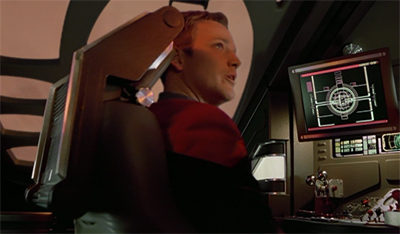
A pilot scheme.
Interestingly, Torres’ depression and self-harm is not the only point at which Extreme Risk fudges continuity. The introduction of the Delta Flyer is treated as pay-off for a long-running plot thread, something that has been teased and foreshadowed for weeks on end. The way that the characters talk about Paris’ obsession with building a new shuttle craft, it sounds like the idea has been seeded as carefully as the Astrometrics Lab had been in fourth season episodes like Revulsion and Scientific Method.
“Let’s face it, class-two shuttles just don’t cut it in the Delta Quadrant,” Paris advises the staff. “We’ve needed something bigger and better since we got here. It’s time we built it!” Chakotay politely tries to shut him down. He responds, “Tom, we’ve been through this I don’t know how many times. We all appreciate your enthusiasm.” However, the audience does not appreciate Paris’ enthusiasm. This is the first time that the viewers have seen Paris mention the idea. The closest thing to foreshadowing is a remark from Seven of Nine in the teaser to Drone.
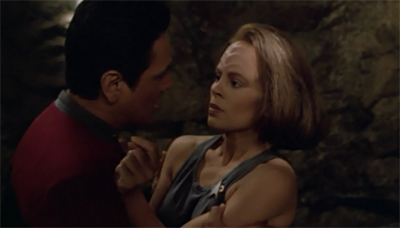
Gripping stuff.
Still, this is far from the most frustrating way in which Voyager‘s lack of continuity hobbles Extreme Risk. Like Night before it, the ending of Extreme Risk suggests that clinical depression is something that be defeated and vanquished through dynamic action. Janeway seems to pull herself out of her funk by defeating the Malon and getting Voyager out of the “void.” Torres finds faith in herself by improvising a repair mechanism that saves the lives of her friends.
These are certainly heartwarming resolutions, but they belie the real horror of depression. Depression does not go away because a person has a good day. Sometimes, depression does not even grant a reprieve because a person had a good day. The truth is that depression is not a threat that can be beaten through one superlative day. Many people battle their entire lives with depression. In Night and Extreme Risk, Voyager offers a very trite and cynical portrayal of the illness that has been reworked to fit within the show’s preferred format.
The result is underwhelming.
Filed under: Voyager | Tagged: continuity, delta flyer, depression, star trek, star trek: voyager, Technology, the delta flyer, torres, voyager |




















I watched a few TED talks that suggest depression is an untreatable symptom of modernity, in a culture where few us of have any power over it and most of the big decisions are decided for us. I’m not convinced yet, but it is a compelling and plausible idea.
It’s an interesting idea, although I’m reluctant to embrace any theory that mental illness is more common today than it used to be. I suspect diagnosis and awareness is more common today, but I suspect there were a lot more undiagnosed (and unreported) mental illness cases in the past than these sorts of statistics would lead us to believe.
It’s interesting reading this review given I’m rewatching ‘Buffy the Vampire Slayer’ and the current season I’m watching is the polarisizing Sixth Season where our heroine suffers from clinical depression for essentially a full year in screen terms.
It’s weird to see it get such short shrift in a contemporary fellow genre show and I guess makes it feel even more of discredit to Torres and Dawson.
Yeah, the fifth season of Voyager has a lot of this, a reminder of just how Voyager was rooted in eighties storytelling at the turn of the twenty-first century.
There is a third layer of disregard for continuity in this episode, aside from Torres’ sudden depression and Paris’ shuttle pet project. The construction of a shuttle from thin air is like some huge middle-finger to any observant fans, who have seen about a dozen shuttles get destroyed, and who have been told repeatedly that Voyager barely has the resources to replicate soup. Now suddenly they are able to produce a brand new advanced craft in a matter of days.
Why hasn’t Voyager been building shuttles and robotic drones? Or maybe they HAVE been rebuilding shuttles in a micro factory on board?
The technology of replicators and ship construction just makes zero sense and seriously damages the viewer’s suspension of disbelief.
One gets a strong sense that the Voyager writers were just jealous of the Defiant on DS9, and wanted their own version of that.
Watching this episode in era where discussion on mental health issues has some kind of betterment (albeit a tiny bit), the story seems more harmful than I think. Just with one act, the depression gone almost instantly. I had a fair share of people telling me to “Just don’t be sad.”, or “You’ll shake it off soon.” when all I saw is nothingness and the logical conclusion is an ending for myself. Torres’ glad face when she’s eating pancake and Janeway’s proud face in the end of the Night reminded me of the mind frame of that kind of people again.
I know it stupid to expect a flawless mental health depiction in sci-fi show, let alone Star Trek, but sometimes the series is just too obsessed with perfectly resolving everything in the end. One ending I like the most is from Necessary Evil in DS9, when Odo found out Kira has not been truthful to him about the murder, even though Odo said that the revelation may not affect their friendship, he couldn’t answer when Kira asked if he’ll ever be able to trust her again. That’s it. I hope they let the characters development to organically improve and tell the stories of their own.